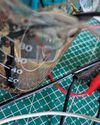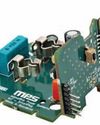"Top Companies Need HIGHLY SKILLED MANPOWER And That Number Needs To Be INCREASED IN INDIA"
June 2023
|Electronics For You
Commenting on the industry-academia gap and the need for better training, International Institute of Information Technology Bangalore’s Director, Prof. Debabrata Das, tells Yashasvini Razdan from Electronics For You, how IIIT Bangalore is enhancing its curriculum to create better engineers who can contribute vastly to the Indian ESDM sector

What is the goal of setting up an institution like the International Institute of Information Technology?
It's a very good question, as you are going straight to the fundamentals of why IIIT was created. IIIT Bangalore was started in 1998. At that time India was poised to take a spring into the information technology industry. This was in the last century, and at that time, the Y2K problem was very large across the globe and a lot of manpower was needed in the information technology sector from India to solve the Y2K problems across the globe. Hence, the government of India and the state governments of India found that more manpower was needed in this niche technology area.
So, to give importance to information technology-industry and academia this new set of institutions was set up at that time, called as IIITs. The main aim of these institutions was to focus on the broad areas of information technology (IT), because IT can be used in agriculture, space, education, and health for the upliftment of society, businesses, banks, and finance. These institutions mainly teach to uplift or train new members and also do deep research.
Why did the government not just set up more Indian Institutes of Technology (IITs) focused on the same instead of establishing a completely different set of institutions?
There have been more IITs set up after 2000. Before 2000, there were only six IIITs, but 17 more IITs were added later on. IITs are much larger because there are at least 10 departments ranging from mechanical, chemical, civil, electronics, electrical, computer science etc.
هذه القصة من طبعة June 2023 من Electronics For You.
اشترك في Magzter GOLD للوصول إلى آلاف القصص المتميزة المنسقة، وأكثر من 9000 مجلة وصحيفة.
هل أنت مشترك بالفعل؟ تسجيل الدخول
المزيد من القصص من Electronics For You

Electronics For You
Tech Majors Are Racing TOWARDS NET-ZERO - What About You?
Apple, Microsoft, Amazon, Google, Infosys, Wipro—global and Indian firms are heading closer to achieving net-zero emissions, a mandate to combat climate change. Here is what you need to know to start your journey...
12 mins
December 2025

Electronics For You
Miniature IoT WATER TDS And LEVEL MONITOR Cum CONTROLLER
For setups that rely on stored water, clear awareness of tank level and water quality is essential.
3 mins
December 2025

Electronics For You
The Impact Of GENERATIVE AI On The Future Of AUTOMOTIVE AND EVs
Autonomous vehicles, connected ecosystems, and smart factories are only the beginning. Generative Al is pushing the auto industry beyond predictions into a bold era of creativity-from EV design to real-time diagnostics and showroom automation. Here is how GenAl is reshaping innovation across the automotive value chain.
8 mins
December 2025

Electronics For You
How AI Tools Are Making SOFTWARE DEVELOPMENT BETTER
AI is reshaping how we code, debug, and collaborate. From Copilot to automation, it is changing software development in ways worth exploring.
3 mins
December 2025
Electronics For You
How AI Tools Are Making SOFTWARE DEVELOPMENT BETTER
AI is reshaping how we code, debug, and collaborate. From Copilot to automation, it is changing software development in ways worth exploring.
3 mins
December 2025

Electronics For You
5 Interesting Reference Designs FOR SMART HOMES
Smart home devices are transforming the way people interact with their appliances. They make homes more convenient, secure, and energy-efficient. From smart plugs and energy monitors to smart locks and thermostats, reference designs help design engineers create connected products that are easy to use, consume less power, and are reliable. These designs allow you to control devices remotely, track energy use, extend battery life, and automate routines. They provide practical solutions for upgrading homes and small commercial spaces without major modifications.
3 mins
December 2025

Electronics For You
Fancy USB LED VASE
This USB LED vase is a simple yet elegant device that fuses art with electronics to create a decorative lighting display. Powered directly from a standard USB port, it uses readily available components such as MOSFETs, resistors, capacitors, and LEDs to produce a striking, dynamic sequence of lights.
3 mins
December 2025

Electronics For You
"WHAT OTHERS SELL IN FOUR BOXES WE BUILT IN ONE"
Years of custom field work are shaping a product line with its own cloud, its own hardware, and a market that is now beginning to recognise its value.
8 mins
December 2025

Electronics For You
BUILD LARGE LANGUAGE MODELS
Large language models are machine learning models designed for a range of language-related tasks such as text generation and translation. Here’s how open source software can help you build your own large language model.
6 mins
December 2025

Electronics For You
Rare Earth Or Rare Ingenuity? India Remains Between The Two
With China firmly controlling rare earth exports, India confronts a critical moment in its technological trajectory.
8 mins
December 2025
Translate
Change font size

